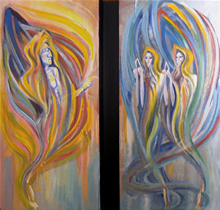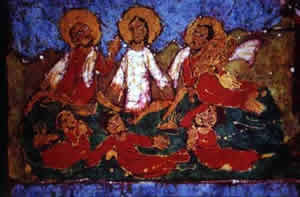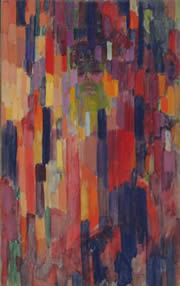The Dial and the Switch:
Recognizing the Moments of God's Special Visitation
Guest essay by Pam Fickenscher. Pam is a pastor of Edina Community Lutheran Church in Edina, Minnesota. Her essay, "Everything I needed to know about postmodern ministry, I learned mountain biking," will appear in the Christian Century next month.
For Sunday February 18, 2007
Lectionary Readings (Revised Common Lectionary, Year C) hotlink: )
Exodus 34:29–35
Psalm 99
2 Corinthians 3:12–4:2
Luke 9:28–36 (37–43)
Coptic transiguration icon. |
The first two chapters of Luke’s gospel read like a Broadway musical, with people continually breaking into song. All the major themes of Luke are there: the power of the Spirit, good news to the poor, the joy of the Lord, the fulfillment of prophecy. Many scholars suspect that this part of Luke was in fact a prologue, or a “prequel,” as the modern terminology goes. Luke, according to this theory, started out telling his story with John the Baptist in chapter three, but when he got to the end of the gospel he thought it best to go back and do a little explaining about where this Jesus had come from.
Read like this, Luke’s story of the transfiguration in 9:28–36 is that much more startling. There are plenty of signs of Jesus’ anointing in chapters 3 through 9, but nothing in the realm of heavenly choruses. At Jesus’ baptism, we only know that there was a “voice from heaven,” but there’s no indication that anyone besides Jesus heard it. He is simply one of the crowd baptized by John when the Holy Spirit descends upon him.
Even so, you’d think that the events at the transfiguration would not have been so startling to Peter, James and John. Surely they had seen enough miracles from Jesus by now to have some suspicion who it was they were dealing with. You’d think, bit by bit, they would have come to the realization that Jesus was the Messiah.
 |
Painting of the Transfiguration by Curtis Doll. |
But Luke makes it clear that they simply had not been paying that much attention: "Now Peter and his companions were weighed down with sleep; but since they had stayed awake, they saw his glory and the two men who stood with him" (Luke 9:32).
Luke has not warned us before that this was taking place at night, so this might be more than physical drowsiness at work. The disciples have been weighed down with the kinds of cares that keep them from seeing clearly what is right before their faces; now, though they are still sleepy, Peter, James and John are awake enough to see Jesus’ glory.
Staying awake is usually an Advent theme in the church year, but it is no accident that this text appears every year as we head into Lent as well. If it took the dazzling transfiguration of Jesus before their very eyes to wake these apostles up, what will it take for us to see God’s presence in our lives? What are the signs in our world that we regularly overlook because we are simply too weighed down with other things? And why, when we are finally given the opportunity to wake up, do we so often misinterpret the meaning of these revelations?
As our world becomes increasingly aware of climate change, specialists in the field talk of the “the dial and the switch.” Scientists agree that the mean temperature is rising, and all that remains to be seen is the degree of the change and its impact in each part of the world. Although the global thermostat may behave as if a hand were turning it up at a steady but glacial pace, not every ecological change will occur as if on a dial, one step at a time. Some local ecologies and some species will respond as if a switch had been flipped, and it will seem as if the change had occurred overnight. One year a species of bird will migrate; the next, it will not. One year the salinity of the ocean will support the sea life we’re accustomed to; the next year, as arctic ice melts, it will not. That the dial is turning, no serious scientist disputes. The question for all of us, however, is when the switch flips.
 |
The Transfiguration by Solomon Raj. |
Theologians describe this difference with the biblical terms chronos and kairos. Chronos is the dial, the constant ticking of clock time which we can measure and track at any given moment. Use an atomic clock or a sundial, whatever. Chronos is steady and will help you get your bearings at any time. Kairos, however, is more like the switch on the wall in a dark room you’ve never entered before. You do not know for sure it is there until the light is on, or at least until your groping gets your finger on it. The fullness of time, the special moment of God's visitation, the biblical writer calls it: when the time is right.
This Transfiguration Sunday is the kairos moment when Jesus’ revelation moves into another mode altogether. The season of Epiphany has been about the light going on, about revelation as we have moved from earthly places of stable and river, weddings and fishing boats, to this mountain. The kairos light is startling, beautiful, and sometimes enthralling, but on this mountain it is revealed that Jesus’ mission will take him still farther, to the valley of the shadow of death. The heavenly light breaks our darkness, but it also makes the shadows grow longer. The switch is flipped and what we see is a world not at all ready to accept good news for the poor and the year of the Lord’s favor.
 |
Painting by Frantisek Kupka. |
Still, the kairos moment of transfiguration is a gift, an alarm clock reminiscent of Paul’s words that we hear annually on Ash Wednesday: "As we work together with him, we urge you also not to accept the grace of God in vain. For he says, 'At an acceptable time I have listened to you, and on a day of salvation I have helped you.' See, now is the acceptable time; see, now is the day of salvation!" (2 Corinthians 6:1–2).
Now we see Christ’s presence among us. Now we see that this one who had the power to heal others will remain faithful to the law and the prophets, that he will do what must be accomplished, even though it will mean suffering for him. Now, we are called to awaken to Christ’s presence among us, and to follow him to all the places he has promised to be: among the least of these, the poor, the sick, and the imprisoned. May we learn to say, “How good, Lord, to be here.”
For further reflection
- What have been the kairos moments in your journey with Jesus?
- What weighs you down with sleep and keeps you from seeing Christ’s presence with you? From seeing the necessity of suffering in following him?
- What do you imagine was the conversation between Moses and Elijah and Jesus at the transfiguration?





